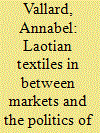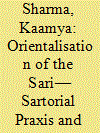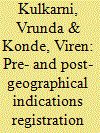| Srl | Item |
| 1 |
ID:
108969


|
|
|
|
|
| Publication |
2011.
|
| Summary/Abstract |
The policies of the United Nations Educational, Scientific and Cultural Organization (UNESCO) related to heritage preservation and promotion have been spreading worldwide for the past few decades. This ethnographically focused paper examines two UNESCO devices, the Crafts Prize and the Awards of Excellence for Handicrafts, as they apply to the contemporary Laotian textiles scene. It questions in particular the uses and values locally assigned to these international certifications of excellence and their mobilisation in the commoditisation of fabrics. On a larger scale, it considers what those devices reveal and entail regarding a 'traditional' handicraft that is, from now on, entangled between trade and the 'politics of culture'.
|
|
|
|
|
|
|
|
|
|
|
|
|
|
|
|
| 2 |
ID:
165930


|
|
|
|
|
| Summary/Abstract |
This article analyses the homologies between colonial knowledge projects and post-colonial revival programmes through Indian textiles and dress. In the nineteenth century, the colonial bureaucracy treated Indian textiles as samples of ‘native’ artisanship, using them to police discourses of race, gender and citizenship. Concomitantly, the nationalist movement created a model of Indian womanhood that conscripted women to be both ‘traditional’ and ‘modern’, signified in the Nivi sari, linking this to emerging craft conservation movements. Post-Independence, elite women became the directors of craft revival by linking sartorial taste to ideal womanhood in a continuation of colonial discourse.
|
|
|
|
|
|
|
|
|
|
|
|
|
|
|
|
| 3 |
ID:
110488


|
|
|
|
|
| Publication |
2011.
|
| Summary/Abstract |
Over the recent past, Geographical Indications (GIs) have emerged as a significant form of intellectual property rights in the Indian context. In view of the commercial potential of handicrafts, adequate legal protection of GIs becomes necessary to prevent their unauthorized utilization. The illegitimate practice of using geographical names not only damages the reputation of the original product, but also deprives the genuine right holders of the returns on investments for developing goods and its reputation in the market. Moreover, the consumers are likely to be misled into purchasing the counterfeits. This paper provides an overview of the current status of registered GIs and their classification with respect to handicrafts and their region-wise registrations. More importantly, this paper focuses on the need to improve the existing pre-and post-registration GI measures along with its reinforcement measures as critical factors to the success of the handicrafts industry in India.
|
|
|
|
|
|
|
|
|
|
|
|
|
|
|
|